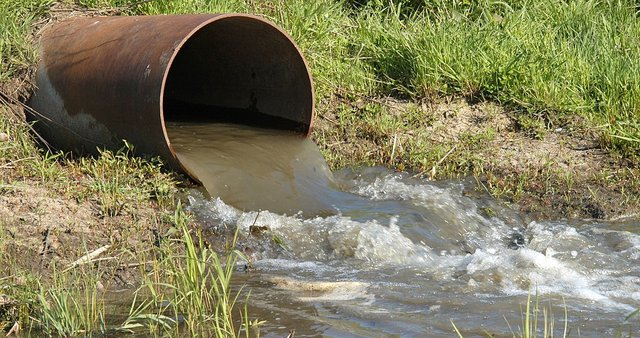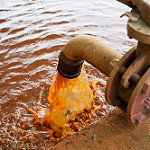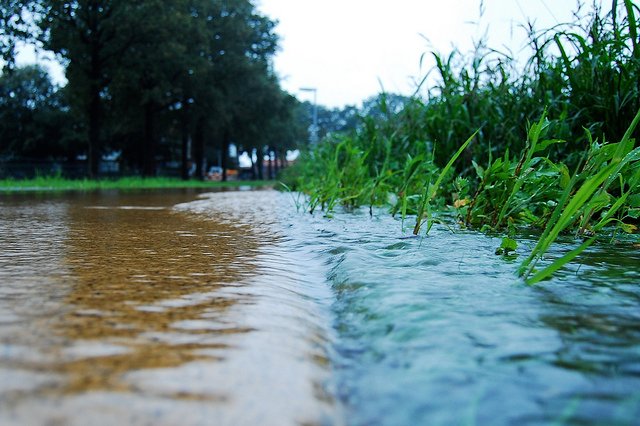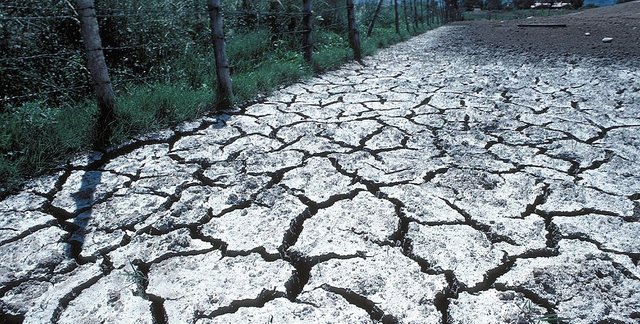Wastewater: A typical issue in our immediate environment
When we talk about wastewater, we are talking about any type of water that is usually not good for direct consumption or direct use. And this is usually because of the kind of impurities that are found in the wastewater. A long time ago the reuse of wastewater has been in practice even though there was no much technological development as at then.

Water not suitable for human consumption. Photo credit Wikimedia. Creative Commons license.
In most cases, wastewater reuse is dominant in areas that have less access to clean and safe natural water resources and this wastewater reuse is done in order to have enough water for agricultural purposes and also domestic purposes as well. With the drastic increase in the human population in the early 19th century which was one of the reasons which lead to the development of wastewater collection and treatment. This development has greatly improved in ways that are biologically, physically and mechanically fit and are available for use.
In the early 21st century, there was serious water quality degradation as a result of water pollution from several urban drainage outlets into fresh water sources which affected the quality of groundwater sources. There was also a large amount of groundwater which was depleted because of drought especially in the arid (dry) and semi-arid regions. There was also a great increase in population and this, in turn, caused a demographic imbalance especially in urban areas while that of rural areas are minimal.
))
Large influx of people in the urban areas is the major cause of water quality degradation in such areas. Photo credit Flickr. Image by BruceBlaus. CC BY 2.0
This is as a result of the constant inflow of people into the urban areas in a bid to find and have a better life. Apparently, all these became a concern for the need for fresh clean water which leads to wastewater reuse and management in order to improve the health and well-being of the population through an enhanced wastewater management to reduce pollution in used water that is constantly discharged into the environment and encourage the conservation of water for future use
Though there's still large distribution of clean water around the globe, some countries and regions still experience water stress while some suffer clean water scarcity and critical examination of the situation reveals that a lot of countries and regions will still suffer from the same water stress and scarcity in the nearest future.
A study stipulated that come 2025 that there will be about 60% of the population of the world that will suffer from water scarcity and we all know that this will, in turn, affect the health and so many other aspects of the economy of such a region. All these speculations have made the drive to increase a sustainable water supply for water resources management which will be environmentally safe for the teaming population at large.
Characteristics of wastewater
The principal reason for the improvement of water quality for the public is to ensure that there is an increased quality water supply that can be used for both industrial, domestic, commercial, and agricultural purposes as well as a wide range of water use in other sectors of the economy. And this is because there are lots of known and unknown impurities that come along with these water after they must have been used by the different sectors thereby forming wastewater and because wastewater is usually recycled from sources including sewage networks, run-offs, stormwater, drainage water and industrial water.
Let's discuss the characteristics of wastewater with respect to their sources.
Municipal wastewater or urban wastewater
These usually are made up of a combination of some or all of the domestic water effluents that are produced by either commercial or public establishment or institution usually factories.
))
Wastewater effluent. Photocredit Wikimedia. Creative Commons license.
Most cases of wastewater that are discharged from industrial effluents and storm water which has not infiltrated the soil, as well as other urban run-offs, form the municipal or urban wastewater.
Following this explanation, therefore, wastewater can be said to contain one or even more impurities at levels that are more than in fresh water and these impurities include salts and saltlike substances, organic compounds, metals and metalloids, drug waste, compounds that can destroy the endocrine as well as personal care products and/or pathogens contained in the wastewater.
Industrial wastewater
When we talk about the industrial wastewater, we refer to all the wastewater that is produced from all forms of production industries.
))
Photo credit Flickr. CC BY-ND 2.0
The wastewater is accumulated from different processes all within the production premises. These industrial wastewaters are of different types and they contain different particles which could be from synthetic materials, organics, chemicals which can be complex in nature. Whichever form it comes, they are all water Bourne waste.
Stormwater
Whenever it rains, no matter how light or heavy the rain may be there is always surface run-off of the water into different channels. As we all know that these run-offs are usually dirty water that Carry a lot of impurities with it into channels and that is why stormwater can be said to be surface run-offs that emanated from precipitation.
))
Stormwater. Photo credit Flickr. CC BY 2.0.
As this water run over different surfaces, they wash along and carry so many disease-causing microorganisms that are harmful to the health of humans and they also carry with them contaminants of varying forms such as animal faeces, grease, and oil, metals, fertilizers, pesticides, and herbicides as well as some decayed or decaying materials.
In most cases, as the water passes through the soil on irrigated lands, it passes through the soil profile and then infiltrates into the soil into drainage systems and these drainages are usually saline in nature because they contain salts and different types of agro-chemicals which can disrupt the healthy growth of plants and cause soil salinization and waterlogging.
Environmental health risk and public concerns of wastewater application
In the present, The utility assessment of any wastewater source depends on the parameters that affects the water quality of any receiving water body and this for instance, if the receiving water body for the wastewater is a lake or a stream, the nutrients that are present in the water like nitrogen and phosphorus in the wastewater may be a major concern and this is because it can affect the ecology of the water. Most of these Nutrients, when discharged into the lake or river, can lead to eutrophication, a condition that degrades water quality by increasing algae growth.
Illustration of eutrophication. Wikimedia Creative Commons Attribution-Share Alike 3.0 Unported license.
And this can increase the amount of sediments in the water body. If the receiving stream is a high quality river, the primary concern may be oxygen consuming organics in that are present in the water. A reduction in the oxygen level in the river could lead to deterioration in the quality and diversity of fish species, and when there is a severe oxygen depletion, it can as well lead to fish kill.
The failure to properly treat and manage wastewater for irrigation purposes may generate adverse health effects especially on humans and this is because Leafy vegetables when eaten raw can transmit contaminations from farm feeds to consumers.
For example, Hookworm infections can be transmitted by direct exposure to contaminated water and soils. A high occurrence of infection in a population can be linked with the widespread use of wastewater in agriculture.
Effects on human health
There are so many studies as well as reports that have shown results and demonstrations that even food crops that are consumed uncooked could be successfully irrigated with reclaimed water from wastewater without any adverse environmental or health effect. Recent studies have shown the safety and suitability of such reclaimed water in agricultural irrigation. Some toxic ions in treated wastewater can be deposited in the roots of plant crops which can impair the growth of these crops or even damage and reduce harvests of these crops.
The ions that are usually present in treated wastewater are mainly boron and sodium chloride which are found mostly in household detergents as a result of the increased use of this detergents for domestic purposes and it becomes more when water softeners are also used while others are from effluents discharged from industrial plants. If the crops involved in irrigation from this reclaimed water are sensitive, it would be very difficult to correct the number of toxins already absorbed by the plants if the water supply is not changed to a fresh water supply for agricultural irrigation.
Effect of salinity on crops
Several types of treated wastewater effluents have either a moderate amount of saline or a high amount of saline in it and on the long-run, when this type of water is used constantly for irrigation, it may affect both the physical and the chemical properties of the soil especially for agricultural practices in the arid and semi-arid regions.
Also, when fertilizers are not used properly on the soil can cause a high buildup of salinity in the soil and also if wastewater is used for irrigation over a long period of time can cause soil compaction which can lead to reduction of the nutrient holding capacity of the soil and as salinity increases in the soil as a result of excessive use of wastewater for irrigation, it will increase cropping problems.
Effect of sodium on soil structure

High concentration of sodium and its compounds in wastewater causes aggregated of soil particles to break down affecting water movement in the soil which in turn causes puddling as shown above. Wikimedia. Photo courtesy of USDA Natural Resources Conservation Service. Creative Commons license.
In addition to their effect on the plant, sodium in irrigation water gotten from wastewater may affect soil structure and thereby reduce the rate at which water can move into the soil as well as it can reduce soil aeration and as a result of this the infiltration rate of water and air is greatly reduced and can also make it impossible to supply the crop or landscape plant with enough water for a better plant growth. A permeability issue usually occurs in the first few centimeters of the soil and is mainly related to relatively high sodium or very low calcium content in this zone.
Damages to plant foliage
Another possible problem of wastewater reuse is the excessive residual chlorine found in treated effluents of wastewater which can cause Possible damages on plant foliage.in most cases, this could occur when the sprinklers are used and the concentration of residual chlorine is higher than 1mg which is supposed to be the maximum amount of chlorine that should be contained in a portable water.
Conclusion
In any way wastewater is to be treated and used either directly or indirectly into any potable water distribution network for domestic and industrial use, the main concerns that should be considered in the water are the presence of pathogens, heavy metals and or carcinogenic substances as well as any substance that could possibly produce any health risk.
In the case of blue-baby symptoms or methemoglobinemia, this happens as a result of high level of nitrate that is present in the drinking water produced from wastewater and because babies are known to secrete lower amount of gastric acid in their digestive system makes it more risky to their health.

Eutrophication resulting from overfertilization caused by excess nitrates and phosphate which leads to deoxygenation of our water sources is a major problem for sure...Am glad you touched on that.
Thanks for this awesome write up
Glad you learnt something as well.thanks
This post has been voted on by the steemstem curation team and voting trail.
There is more to SteemSTEM than just writing posts, check here for some more tips on being a community member. You can also join our discord here to get to know the rest of the community!
Congratulations @xbae! You have completed the following achievement on Steemit and have been rewarded with new badge(s) :
Click on the badge to view your Board of Honor.
If you no longer want to receive notifications, reply to this comment with the word
STOPCongratulations @xbae! You received a personal award!
You can view your badges on your Steem Board and compare to others on the Steem Ranking
Do not miss the last post from @steemitboard:
Vote for @Steemitboard as a witness to get one more award and increased upvotes!